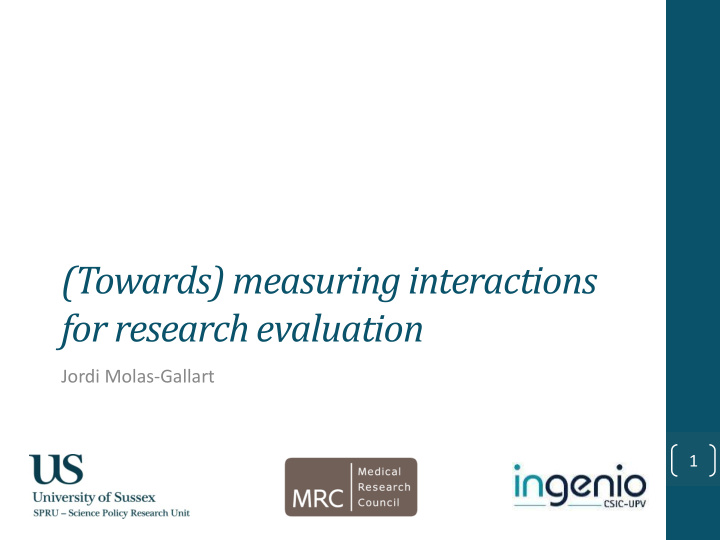



(Towards) measuring interactions for research evaluation Jordi Molas-Gallart 1
Starting point: a challenge • Many promising results from basic science (in biomedicine) have not contributed to applications (medical treatments/ health care improvements) valued by society … or the application has been very delayed • Need to “translate” the knowledge of physical phenomena to the development of applications, solutions, practices • Diagnosis (among others): there are divides among different actors involved in the development and application of new drugs, therapies, diagnostics or public health practices • Translational research attempts to address these divides 2
Defining the problem (1) • Bridging problematic “translational gaps” separating different stages in the research and application process • The influence of the “pipeline” or “pass the baton” view 3 September 28, 2013
Implications for evaluation: addressing the gaps in the “translational continuum” • Focus on outputs,… outcomes and impacts • Challenge: different ways of identifying gaps and addressing them. • “Different measures, of different things, at different time points” (Morris et al., 2011) • Solution: agree models and definitions • Trochim et al. (2011) propose a generic evaluation model (i) identifying “markers” in the translation continuum • (ii) Measuring the time that it takes for outputs to move across markers 4
Process marker model (Trochim et al. 2011) 5
Defining the problem (2) • Identifying outputs and measuring time gaps does not tell us “why” or “how” what we have observed happens • Policy logic: Improvement requires interactions among diverse actors involved in research and the application of its results (researchers, practitioners, patients, etc.) • Diversity means individual elements are distributed among many disparate entities (3 components of diversity: balance, variety, disparity) • Dealing with such diversity poses a policy (and analytical) challenge 6
A diversity approach • Note that in a linear understanding of impact diversity is not a problem • “Passing the baton” is only affected by the differences among two sequential partners • A diversity approach will focus on how diverse actors are networked to face a problem 7
Diversity occurs through many different dimensions (based on Boschma proximities) • Cognitive: extent to which actors share a similar knowledge base • Social: degree to which relations between actors are based on trust, generally built on common experience, friendship and kinship • Organisational: degree to which hierarchical structures governs the interactions among actors • Institutional: similarities in the norms, rules and values that influence how actors behave • Spatial. 8
A Diversity Approach for Research Evaluation • Offers a guiding framework for “narrative - based” evaluation… • … to describe characteristics of the processes by which impact is generated (or hindered) • A multi-dimensional approach, which will (Rafols,…) • “Broaden out” the analysis • Using various data sources and analytical spaces • “Open it up” • Introducing different evaluation perspectives/criteria • It drives us towards a “formative” type of evaluation • Difficult to operationalise quantitatively, but there is scope for developing indicators 9
Recommend
More recommend